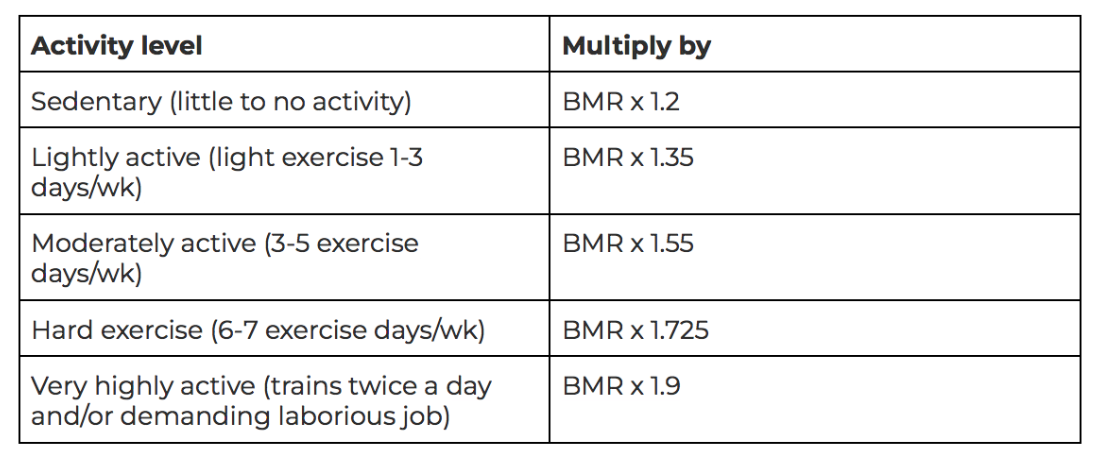What is TDEE, how do you calculate it and how do you use it to help you lose weight?
What is TDEE?
If you work in the health and fitness industry or are a gym rat, you would have heard of the total daily energy expenditure (TDEE), its basically a fancy way of saying how much energy you ‘burn’ in a given day including your gym sessions and your day to day activities.
So if you cycle to work, walk up a flight of stairs to get to your office and then spend an hour at the gym before returning home, all these activities count towards your TDEE.
Before we can calculate the TDEE we need to understand how to calculate the BMR or RMR.
What’s the BMR and RMR?
The basal metabolic rate (BMR) is defined as the barest minimum energy required to keep us alive, and resting metabolic rate (RMR) is the energy we use while lying down and doing nothing (like chilling by the TV), and is slightly higher than the BMR.
In order to calculate your TDEE, you’ll have to first calculate either your BMR or RMR.
There are several ways you can do this and if you spend some time on Google you’ll find various TDEE calculators but I’m assuming if you’re reading this blog you’re a bit of a geek and want to calculate your TDEE manually because I dunno, it’s more fun and maybe helps you to understand the science a bit more? #Geeksunited amiright?
How to calculate your RMR and BMR
Before we go into the equations for how to calculate your energy expenditure, its important to understand that these are simply jumping off points. You can never know with 100% accuracy exactly how much energy your body is expending unless you were at a lab.
In addition to our bodies being genetically different, there is also lean body mass to consider.
Fun fact:
Lean body mass — muscle, bone and our connective tissue for example cost more energy to maintain.
Skeletal muscle, for instance, uses about 4 calories per pound per day more than fat does.
So what this means is that a leaner individual will very likely needs MORE food to survive than a person with more body fat.
With that said, let’s continue on with the BMR and RMR calculator.
There are several ways you can do this, and I’m not going to go into detail on all the different ways you can calculate your resting metabolic rate since there are too many equations to list however, I’m going to list two predictive equations that according to updated research, are the most accurate formulas for calculating your TDEE, BMR and RMR.
Sample BMR and RMR calculator
The Katch-McArdle equation for BMR is especially helpful for athletes who’s body weight is made up of more lean mass than the average person.
BMR = 370 + (21.6 x FFM in kilograms)
FFM = (Weight in kilograms x (100 - (Body fat)) / 100)For this equation you’d need to know your fat free mass (FFM).
Mifflin St Jeor calculates the RMR
For men
RMR (in kcal / day) = 10 x (weight in kilograms) + 6.25 x (height in centimeters) - 5 x (age in years) + 5
For women
RMR (in kcal / day) = 10 x (weight in kilograms) + 6.25 x (height in centimeters) - 5 x (age in years) - 161
If you don’t know your fat free mass (FFM) use the Mifflin St Jeor formula.
Remember that if you already know your FFM, you’ll just use the Katch-McArdle equation but if you don’t, use the Mifflin-St Jeor.
Once you have your RMR or BMR, you’ll need to work out how active you are during any given day. Again, these are a rough guideline and each person’s results may come out a little higher or a little lower depending on many factors including how you categorise your level of activity.
*Use this multiplier to work out your TDEE.
It’s important to note that athletes that train at extremely high volumes such as iron man events or triathlons may need to increase that multiplier even more.
Next, decide whether you want to gain, lose or maintain weight.
If the goal is to maintain weight then you’d simply use that number as your energy target.
However, for weight loss or gain here is a guideline:
Fat loss
Lower TDEE by 15-25%.
Muscle gain
Increase TDEE by 5-15%.
Now if you’re wondering whether you can just lose fat and gain muscle simultaneously, my answer will always be it depends. If you are a well trained athlete then very unlikely, no. However if you are new to the world of exercise and fitness, probably yes.
It’s important to note that for most trained athletes, trying to achieve muscle gain during a fat loss phase is like trying to bail out water from a sinking boat with a tea cup. Not gonna happen.
How come some people look like they’ve built muscle after a fat loss phase?
If you’ve seen some athlete’s muscles suddenly pop after a period of fat loss, this can often be misconstrued as muscle gain. This is because in the process of dropping body fat, the muscles that were previously hidden under their body fat has now been revealed, which can often look as if they have suddenly gained muscle.
How to increase your TDEE
Now that we have established how to calculate your TDEE, the next logical question is, well how do we increase it for weight loss? Assuming that is what you want to achieve of course.
Most people are under the impression that your workouts amount to the highest energy expenditure across a 24 hour period. In reality it’s how you spend the rest of your day that makes up the majority of your calorie outgoings.
No two days are the same, some days you’re sat at a desk catching up with emails, other days you’re running around doing errands or cleaning the house.
Here are some simple strategies to increase your overall energy expenditure through out the day:
Walk or cycle to work if applicable
Always take the stairs when you can
Spend some time in the garden if you have one
Hand wash the pots and pans
Hang out your laundry instead of using a tumble dry
Iron your underwear and socks (I’m just kidding, if you’ve gotten this far in the blog I’m just impressed and super appreciative)
Conclusion
Energy balance matters regardless of your age, sex or other biometrics, however understanding the basic science behind it means that you can adjust the numbers to suit your personal circumstances so that you can achieve your body and performance goals.
As always, I’ll sign off with a friendly reminder that whatever goals you have, remember to approach them some self compassion and patience.




